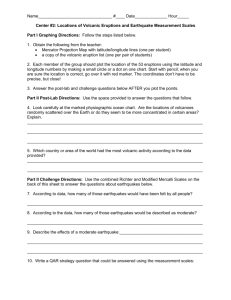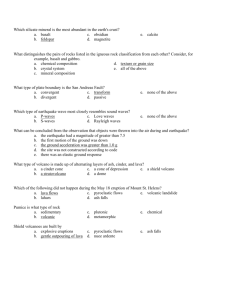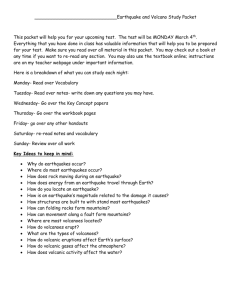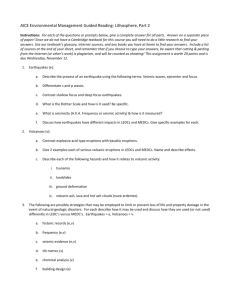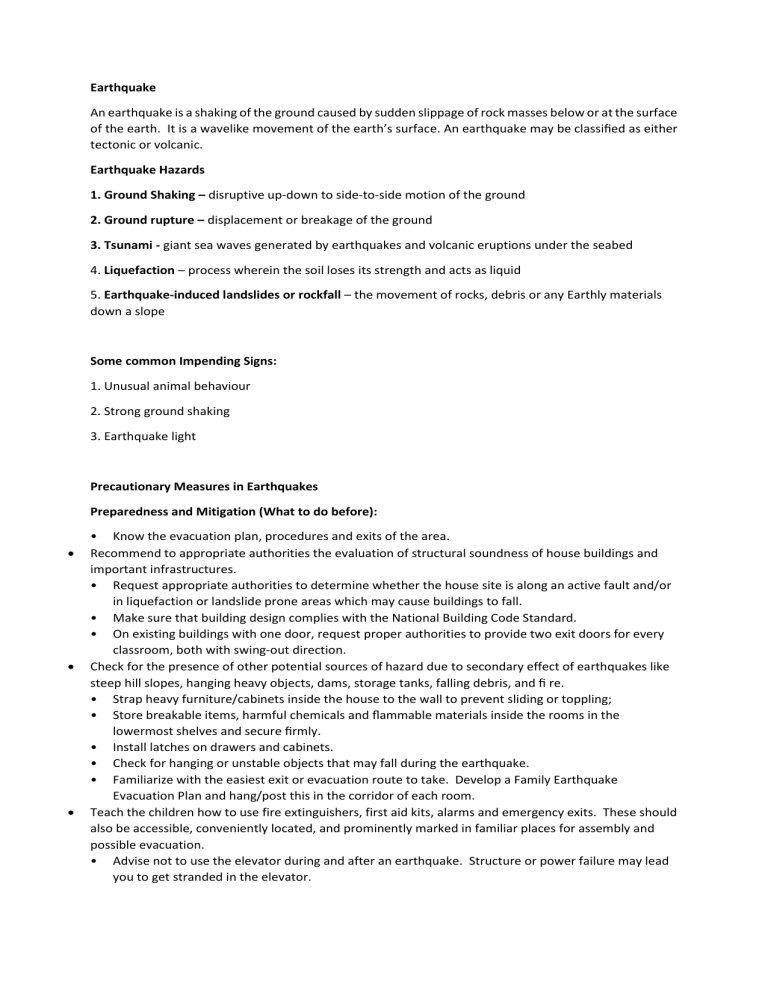
Earthquake An earthquake is a shaking of the ground caused by sudden slippage of rock masses below or at the surface of the earth. It is a wavelike movement of the earth’s surface. An earthquake may be classified as either tectonic or volcanic. Earthquake Hazards 1. Ground Shaking – disruptive up-down to side-to-side motion of the ground 2. Ground rupture – displacement or breakage of the ground 3. Tsunami - giant sea waves generated by earthquakes and volcanic eruptions under the seabed 4. Liquefaction – process wherein the soil loses its strength and acts as liquid 5. Earthquake-induced landslides or rockfall – the movement of rocks, debris or any Earthly materials down a slope Some common Impending Signs: 1. Unusual animal behaviour 2. Strong ground shaking 3. Earthquake light Precautionary Measures in Earthquakes Preparedness and Mitigation (What to do before): • Know the evacuation plan, procedures and exits of the area. Recommend to appropriate authorities the evaluation of structural soundness of house buildings and important infrastructures. • Request appropriate authorities to determine whether the house site is along an active fault and/or in liquefaction or landslide prone areas which may cause buildings to fall. • Make sure that building design complies with the National Building Code Standard. • On existing buildings with one door, request proper authorities to provide two exit doors for every classroom, both with swing-out direction. Check for the presence of other potential sources of hazard due to secondary effect of earthquakes like steep hill slopes, hanging heavy objects, dams, storage tanks, falling debris, and fi re. • Strap heavy furniture/cabinets inside the house to the wall to prevent sliding or toppling; • Store breakable items, harmful chemicals and flammable materials inside the rooms in the lowermost shelves and secure firmly. • Install latches on drawers and cabinets. • Check for hanging or unstable objects that may fall during the earthquake. • Familiarize with the easiest exit or evacuation route to take. Develop a Family Earthquake Evacuation Plan and hang/post this in the corridor of each room. Teach the children how to use fire extinguishers, first aid kits, alarms and emergency exits. These should also be accessible, conveniently located, and prominently marked in familiar places for assembly and possible evacuation. • Advise not to use the elevator during and after an earthquake. Structure or power failure may lead you to get stranded in the elevator. • • • • Identify strong parts of the building like near elevator shafts, sturdy tables where the people can take refuge during an earthquake. Prepare and maintain an earthquake survival kit consisting of a battery-powered radio, flashlight, first aid kit, potable water (1L/person/day), candies and biscuits, ready to eat food/ easy-to-open canned goods, whistle, ropes, hygiene kit, dust mask, money, ID’s and important documents Conduct a contingency planning on earthquake. Conduct an orientation and earthquake drill quarterly. Response (What to do during): •Stay calm. Do not panic. Pray. Direct people to stay inside a structurally sound building. • Advise people to protect their body from falling debris by bracing themselves in a doorway or by getting under a sturdy desk or table. Using DUCK, COVER, HOLD. • When inside a vehicle, pull to the side of the road and stop. Do not attempt to cross bridges or overpasses which may have been damaged. • Direct people to move to an open area when they are outside a building or any structure. • Stay away from power lines, posts, walls, and other structures that may fall or collapse. Stay away from buildings with large glass panes. Move away from steep escarpments which may be affected by landslides particularly if they are on a mountain or near steep hill slopes. Listen to proper authorities for updates. Rehabilitation (What to do after): • Advise people to take the fastest and safest way out if caught in an old or weak classroom building. They should be advised to : • Get out calmly and in an orderly manner. Not to rush or push one another. • Not to use elevators, but instead use the stairs; • Check themselves for cuts and for injuries and approach the nearest authority for assistance. • Check the surroundings of the houses – electrical, building walls, water lines, gas tanks • Call the authority to clean up chemical spills, toxic and flammable materials since this is hazardous to untrained people. • Check for fire and if any, have it controlled. Tsunami Tsunamis are giant sea waves generated by earthquakes and volcanic eruptions under the seabed. Not all submarine earthquakes, however, cause tsunamis. Tsunamis can only occur when the earthquake is strong enough (M6.0+) to displace the seabed, creating pressures in the water above it. Tsunami Hazards 1. Large volume of water 2. Strong force of water due to its speed Impending signs: 1. Unusual animal behaviour 2. Unusual water fluctuations or drawbacks 3. Loud roaring sound like a Bullet train 4. Strong ground shaking Precautionary Measures: Preparedness and Mitigation (What to do before): • Conduct an advocacy on tsunami awareness, preparedness and mitigation. Have a regular tsunami drills twice a year. • Turn on your radio and other communication devices to know if there is a tsunami warning if an earthquake occurs and if you are in a coastal area. Listening to proper authorities for updates like NDRRMC. • Assign a focal person to monitor and observe the water recession after an earthquake. • Be aware of the tsunami facts. This knowledge could save your life! Share this knowledge with your friends. It could save their lives! Response (What to do during): • CAUTION: Move away from the beach immediately, if there is noticeable recession (water drawbacks) in water away from the shoreline. • Move inland to predetermined higher ground immediately and stay there. • Stay away from the beach. Never go down to the beach to watch a tsunami coming. • High, multi-story, reinforced concrete buildings are located in some low-lying coastal areas. The upper floors of these school buildings can provide a safe place to find refuge should there be a tsunami warning and you cannot move quickly inland to higher ground. Local Civil Defense procedures may, however, not allow this type of evacuation in your area. • Small buildings located in low-lying coastal areas are not designed to withstand tsunami impacts. Do not stay in these structures should there be a tsunami warning • Staying away from all low-lying areas is the safest advice when there is a tsunami warning. Rehabilitation (What to do after): • Check yourself and your loved ones. • Listen to proper authorities for updates • Stay away from flooded and damaged areas until officials say it is safe to return. • Stay away from debris in the water; it may pose a safety hazard to boats and people. • Save yourself – not your possessions. Volcanic Eruption A Volcanic Eruption is a process wherein volcanic materials such as molten or hot fragmented rocks or gaseous materials are ejected from a volcano. Volcanic Eruption Hazards 1. Lahar – combination of ash fall and water; part of the family of debris flows that are fluids composed of mixtures of water and particles of all sizes from clay-size to gigantic boulders. 2. Lava flow – less dense fluid lava that travels slowly; rarely threaten human life because lava usually moves slowly -- a few centimeters per hour for silicic flows to several km/hour for basaltic flows 3. Pyroclastic flows – gravity-driven, rapidly moving, ground-hugging mixtures of rock fragments and hot gases. This mixture forms a dense fluid that moves along the ground with an upper part that is less dense as particles fall toward the ground. 4. Volcanic gases – gases that are harmful to the human like carbon dioxide, carbon monoxide, methane, sulphur oxide, nitrous oxides and water vapour 5. Tephra falls and Ballistic Projectiles – large boulders and molten rocks that are thrown ballistically in the air; tephra ranges in size from ash (<2 mm) to lapilli (2-64 mm) to blocks and bombs (>64 mm). Densities vary greatly, from that of pumice (<0.5)) to solid pieces of lava with density about 3.0. 6. Debris-flow Avalanches – collapse of the volcanic walls 7. Tsunamis- are giant sea waves generated by earthquakes and volcanic eruptions under the seabed. Impending Signs 1. Volcanic tremors 2. Change in the properties of water a. Acidity b. Color of the water c. Smell of the water 3. Increase in the temperature of the nearby bodies of water 4. Drying/ wilting of the plants or vegetation 5. Unusual animal behaviour 6. Formation of ash cloud 7. Record of seismic activity Preparedness and Mitigation (What to do before): • Close windows and doors to reduce entry of ash if heavy ashfall is expected to hit the community. Bring animals and livestock into closed shelters. • Develop evacuation plans and conduct evacuation drills. • Avoid low places or areas vulnerable to avalanches, rock falls, lava flows and mudfl ows. • Prepare for evacuation if warning for imminent volcanic eruptions or mudflows is raised. • Know the ways of protecting the houses from ashfall, landslides and debris flows by consulting your local disaster coordinating council. • Consult respective disaster coordinating council officials on the establishment of their community counter-disaster response plans. • Know the delineated areas vulnerable to volcanic hazards and assess your risk for dangers. • Appreciate and take advantage of the importance of management of human settlements based on land use planning which considers volcanic hazards. • Learn about your community warning systems and emergency plans. • Develop an evacuation plan. Everyone in the area should know where to go in response to warnings. • Homes in places prone to volcanic eruptions should have pairs of goggles, basic kits and evacuation supply kits. • If you live in a volcano risk area, publish a special section in your local newspaper with emergency information on volcanoes. Localize the information by including the phone numbers of local emergency services Response (What to do during): • Stay alert and awake. Stay indoors if possible. Close all windows and doors. • Follow the instructions that go with the warning. If there is a directive to evacuate, do so immediately. • Advise the people to protect their heads and get away from the area right away if caught in a small rock fall. • Give priority for evacuation outside the area of ash shower to people with breathing problems. They should be advised to cover their nose, preferably with a wet piece of cloth/towel. • Scrape off ashes to prevent heavy loading of the building roofs. When doing so, the following precautionary measures should be observed: • Wear long-sleeved shirts and long pants; • Wear goggles and eyeglasses instead of contact lenses; • Avoid running car or truck engines. Driving a vehicle can stir-up volcanic ash that can clog engines, damage moving parts, and stall vehicles; and • Avoid driving in heavy ash falls unless absolutely required. If unavoidable, the vehicle should be driven at a speed of 60 kph or slower. Rehabilitation (What to do after): • Clear the canals and pathways of ash and other debris. • Hose down the accumulated ash and plant leaves on roofs. • Stay away from the slide area. There may be danger of additional slides. • Check for injured and trapped persons near the slide, without entering the direct slide area. Direct rescuers to their locations. • Listen to local radio or television stations for the latest emergency information. • Watch for flooding after a landslide or debris flow. • Report broken utility lines and suspected damaged buildings to appropriate authorities. • If you have a respiratory ailment, avoid contact with ash. Stay indoors until local health officials advise it is safe to go outside. Volcanic ash can cause great damage to breathing passages and the respiratory system. The top ten provinces at risk to Volcanic Eruptions are: Provinces At-Risk to Volcanic Eruptions 1. Camiguin 2. Sulu 3. Biliran 4. Albay 5. Bataan 6. Sorsogon 7. South Cotabato 8. Laguna 9. Camarines Sur 10.Batanes *Camiguin has the highest risk because the land area is so small such that a volcanic eruption can affect the whole province. *Sulu ranked second because it has the most number of active and potentially active volcanoes. (source: Manila Observatory)
